General
APATOONS: The birth of Animation Fandom
Jim Korkis returns with a column about the early, early days of animation fandom. Back before there was an Internet, when animation historians and fans were forced to communicate using an extremely primitive device. Maybe you’ve heard of it? Paper?

Once upon a time, there was no animation fandom. To include an animation column in a major comic fanzine would have brought an outcry of protest from the readers. Serious fans would have transferred their loyalties to other fanzines because cartoons were just for kids, the same prejudice that haunted comic book collectors in those days. The firth and early development of an animation fandom is probably directly related to efforts of one man and his fanzine which grew into a legend.
In the mid-Sixties, it was the Golden Age of Comic Book Fanzines. Besides Don and Maggie Thompsons’ Comic Art, Bails-Thomas’ Alter Ego, and Spicer’s Fantasy Illustrated, there were countless ditto and mimeo fanzines extolling the virtues of superheroes. Most of the scholarship centered on superheroes from the Forties although there was a growing faction passionately devoted to proclaiming that Marvel Comics were the only worthwhile comics in existence.
Funny animal comics were scorned and considered of little value by serious fans. Animation was merely an interesting diversion and like Funny Animal comics, it was something to amuse small children, a philosophy that seemed to be held as well by the producers of this material. For most fans, the world “animation” merely meant “Disney”. Perhaps the more knowledgeable fans would have included Warner Brothers and Hanna-Barbera in that definition but precious little else since no information on the field existed in any easily accessible format. And in those days before VCRs, many of the classics of animation were not available for viewing or aired during the day when people were at work.
Into this land of ignorance strode Michael Barrier.
His only credential was an unabashed love for Funny Animal comics and Animation. In October 1966, he published the first issue of Funnyworld for Capa-Alpha, the comic book apa started by Jerry Bails which appeared monthly and is currently still going after 320 some issues. Apas are amateur press associations which date back to the last century, when proliferation of small letterpresses made it possible for anyone sufficiently motivated to create his own publication. The first apas were simply trading clubs for home-produced little magazines. In the 1930s, the invention of the mailing comment, wherein other members are addressed in print by name and response is given to what they write, set the stage for the modern apa. Today’s apas physically resemble mosaics of ditto, mimeo, Xerox and professional printing, but in essence they’re mail order cocktail parties, filled with the same fun and misunderstandings associated with that type of social gathering.
Using the science-fiction apas as a guide, Dr. Jerry Bails created the first apa devoted to comic books. The first issue of Funnyworld was fourteen mimeographed pages and the main feature was a listing of Warner Bros. comic books 1941-1966 (remember, this was pre-Overstreet Price Guide). Why was the zine christened Funnyworld? In that first issue, Barrier explained, “There was a comic book called Funnyworld, by the way, although I know nothing more about it than it existed, probably briefly, and probably as one of the multitude of rotten funny animal comic books spawned in the early Forties by the success of Looney Tunes. The more immediate source of the title is, of course, Richard Kyle’s late lamented Wonderworld. Not that I’m going to try to emulate Kyle, except in the most general way; I just dug his zine.”
Barrier’s primary interest was on gathering and publishing information on this unexplored world of funny animals. Richard Kyle was one of the first analytical writers about comic books, digging out new information and looking closely at themes.
Six months later (Funnyworld 5, April 1967) Barrier included in his fanzine his first animation information. At that time, it was a natural extension from his funny animal comic book research since there were many comic books based on animated cartoon characters. Little did Barrier suspect that animation articles would soon displace all talk of comic books. A year later (Funnyworld 9) the fanzine had expanded to forty-six mimeographed pages and Barrier was selling the extra copies he printed for fifty cents. (It was free “for published contributions of art, articles, reviews, letters, questions, answers, news, historical anecdotes and the like.”)
Funnyworld had outgrown its original purpose of being one man’s attempt to uncover information about some of his childhood memories; it had become a rallying center for animation fans who had no other source available for this material. Barrier was developing a well-earned reputation as an animation scholar and expert on funny animal comics and animation. The summer of 1970 saw the release of Funnyworld 12. It was the first offset issue and sold for a dollar. The main feature of the almost fifty-page issue was a still controversial interview with Bob Clampett. More and more animation news, reviews and interviews began appearing in the pages of Funnyworld. The increased press run and the new ability to include photographs expanded the magazine’s reputation. The magazine continued to be published sporadically until issue 16 (Winter 1974-75) which was intended as the final issue. The magazine lost money because it was published infrequently and it was published infrequently because Barrier lacked the necessary financial resources to publish more often. Barrier decided the only way to remedy the situation was to close up shop and devote his time to writing a book on the history of animation and to concentrate on his regular job.
Funnyworld was revived several years later when the magazine was sold to Mark Lilien (after attempts to have others including Bill Blackbeard resume publication of it). Supposedly Lilien was to take over the business end of production, distribution, advertisements, etc. while the editorial control would remain with Barrier. However, after six issues, Barrier resigned because of strong disagreements with the way the magazine was being handled. That resignation officially sounded the death knell for the magazine.
One of the major contributions Barrier made to animation fandom was to stop publishing Funnyworld. Funnyworld was the unquestioned center for animation scholarship and once it disappeared, it forced the development of other magazines to fill the void.
During this period, Mindrot began. Like Funnyworld, it was designed as an apa zine for Vootie, the funny animal cartoonists’ apa. David Mruz, editor and publisher, remembered his school teachers warning him not to read comic books or watch cartoons because they would “rot” his mind, so Mruz created a fanzine for others with similarly rotted minds. The first issue appeared April 1976 and was only two pages long but by the end of the year it had grown to eight pages of offset type devoted to animation and sold to the general public for fifty cents. A favorable plug for Mindrot in Mark Mayerson’s short-lived animation column for Film Collector’s World attracted the interest of many animation fans looking for a place to share animation information.
This influx of interest encouraged Mruz in June 1977 to further expand his fanzine and to develop its familiar format of forty pages in the form of a booklet. Like Funnyworld, the magazine featured lengthy interviews with animators and historic research. Unlike Funnyworld, the magazine featured detailed episode listings of animated series and several regular columns by animation historians including myself whose interest in animation history had been inspired by Mike Barrier’s work. Some potential readers were confused by the title of the magazine so Mruz changed the name to Animania (issue 20, Feb. 1981) and the name change increased sales and recognition (although fans still refer to it as Mindrot when talking). However, Mruz needed to devote more time to his business and his family and the final issue of Animania was 27 (Dec. 1983). Mruz made no farewell announcement and over the years has thought about reviving the title.
Animania inspired other animation fanzines in a similar format including Reg Hartt’s Animazine and Mike Ventrella’s Animato! Since that time Animato!, in particular under the editorship of Harry McCracken, grew into a respected and eagerly-anticipated animation magazine filled with many of the elements that made both Funnyworld and Animania vital sources for animation fans.
One of the most unique creations inspired by Funnyworld and Animania was APATOONS. On May 12, 1981, Don Markstein and GiGi Dane sent out a one-page orange flyer to a select group of fans. The flyer announced the formation of an apa for “animation buffs”. Markstein wrote, “There’s a potential for an animation fandom lurking among publishing fans. We don’t know how many people there are in it, but we do know Funnyworld and Mindrot aren’t being published in a vacuum. That potential has probably always been there, but lately, with more and more lifelong cartoon buffs becoming video collectors, it’s been exploding. Just as comics fandom grew out of science fiction fandom to create its own fan movement 20 years ago, we expect cartoon fandom to come into its own very soon now. That’s the hifalutin’ reason. What actually happened is that as we were cataloguing the latest tape from our mutual cartoon collection, GiGi asked Don if there was an apa where they talked mostly about cartoons. Of course there wasn’t – but there is now.”
Markstein further stated that “we’re hoping for a fairly small group, say about 20-25 members, and definitely no more than 30. Organization will be loose: There will be a roster, a mailing schedule, a copy requirement, a person in charge, and a general expectation (but not an ironclad rule) that those participating will mostly stick to the subject.”
The first issue of APATOONS appeared July 1981 and that first issue had only seven members: Jim Korkis, Alan Hutchinson, Don Markstein, Meera Dane (GiGi’s daughter), GiGig Dane, Marcus Wielage and Rick Norwood. There were sixty pages in that first mailing, although 26 of those were supplied by Jim Korkis who in a rift of unbridled enthusiasm sent in two separate contributions. In addition, Markstein enclosed a 22-page songbook containing the lyrics to over 40 cartoon “ditties” which he had originally done up for the 100th mailing of SFPA, another apa he was a member of at the time.
That first mailing included such items as a Saturday Morning Cartoon Index (1964-1974), samples of Chuck Jones’s syndicated comic strip and a signed self-portrait of Disney animator Ward Kimball. The apa grew rapidly as word of its existence spread from friend to friend.
By issue three, Mark Evanier had designed the official logo for the apa. Evanier, well-known for his scripting of numerous animated shows among many other credits, contributed his thoughts through Wielage’s apazine. However, over the years, the roster has included Mike Barrier (editor of Funnyworld), Dave Mruz (editor of Animania), Mike Ventrella and Harry McCracken (of Animato! fame), Jerry Beck (co-author of the best book on Warner cartoons) and his co-writer Will Friedwald, Leonard Maltin, Tim Fay, Mark Mayerson, Mark Kausler, John Cawley, Fred Patten, Jim Korkis, Dave Bennett, Bob Miller, Nancy Beiman, Milton Gray, Will Ryan, Keith Scott, Dan Haskett and Van Partible just to mention a few of the names who have contributed so much to animation scholarship during the last two decades.
APATOONS held a special animation party at the 1983 San Diego Con where rare animation was screened. In 1985, APATOONS and Get Animated! jointly hosted another party of animation rarities.
Jerry Beck took over as Fearless Leader in September 1984 with issue number 18 after he successfully edited the first APATOONS San Diego Sampler that was distributed in the summer of 1984. Under Beck’s leadership a more professional look and attitude established itself. Some issues would include actual animation cels or strips of animation film. One issue had a 3-D cover while another showcased an original limited edition cel of famous animation birds. APATOONS became the source for preliminary drafts of articles that would later appear in a variety of magazines including Animato! and Animation magazine.
By issues number thirty (September 1986), famed animator Dave Bennett created an official cartoon mascot for the apa, the Rooster. The Rooster appeared throughout the mailing, but his special place of honor was at the beginning of The Clipping File, a collection of animated related newspaper and magazine articles from around the United States, which appears every issue.
In 1990, with issue number fifty-five, animation writer Bob Miller took over the Fearless Leader position from Jerry Beck and set about revamping and expanding the apa. Under his direction, the celebration of APATOONS’ tenth anniversary in July 1991 was marked by the creation of a special San Diego Sampler to coincide with the regular mailing. Copies of the issue were given to the regular roster of members as well as being offered for sale through the Comics Buyer’s Guide and the Get Animated! table at the San Diego Convention which ironically was being held in July after many years of always being held the first week in August.
Over the years, other animation magazines continued to appear and disappear including Animation Planet, Animated Life, Toon, Animation and many others which I will discuss in a future column. For those interested in joining Apatoons which is still going strong as a forum for animation discussion, there is a website run by Harry McCracken and a new Sampler issue available for interested members.
General
Seward Johnson bronzes add a surreal, artistic touch to NYC’s Garment District

Greetings from NYC. Nancy and I drove down from New
Hampshire yesterday because we'll be checking out
Disney Consumer Products' annual Holiday Showcase later today.
Anyway … After checking into our hotel (i.e., The Paul.
Which is located down in NYC's NoMad district), we decided to grab some dinner.
Which is how we wound up at the Melt Shop.

Photo by Jim Hill
Which is this restaurant that only sells grilled cheese sandwiches.
This comfort food was delicious, but kind of on the heavy side.

Photo by Jim Hill
Which is why — given that it was a beautiful summer night
— we'd then try and walk off our meals. We started our stroll down by the Empire
State Building
…
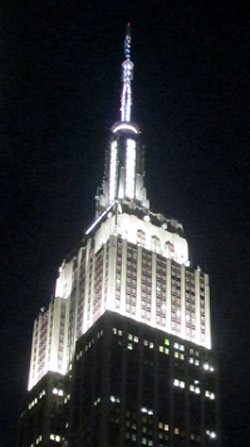
Photo by Jim Hill
… and eventually wound up just below Times
Square (right behind where the Waterford Crystal Times Square New
Year's Eve Ball is kept).
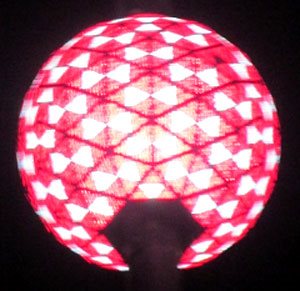
Photo by Jim Hill
But you know what we discovered en route? Right in the heart
of Manhattan's Garment District
along Broadway between 36th and 41st? This incredibly cool series of life-like
and life-sized sculptures that Seward
Johnson has created.
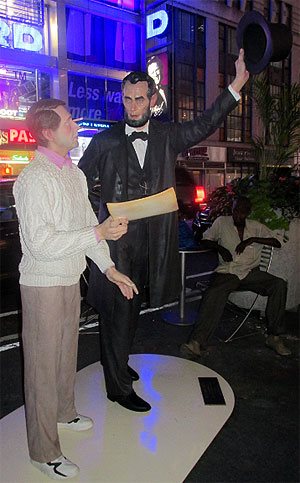
Photo by Jim Hill
And — yes — that is Abraham Lincoln (who seems to have
slipped out of WDW's Hall of Presidents when no one was looking and is now
leading tourists around Times Square). These 18 painted
bronze pieces (which were just installed late this past Sunday night / early
Monday morning) range from the surreal to the all-too-real.
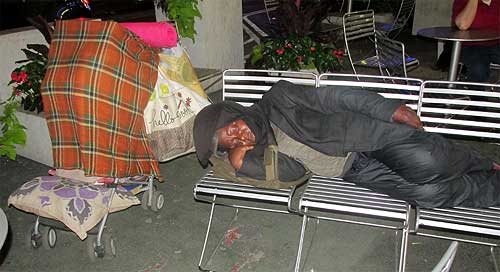
Photo by Jim Hill
Some of these pieces look like typical New Yorkers. Like the
business woman planning out her day …
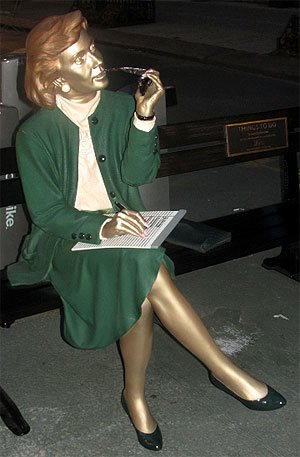
Photo by Jim Hill
… the postman delivering the mail …
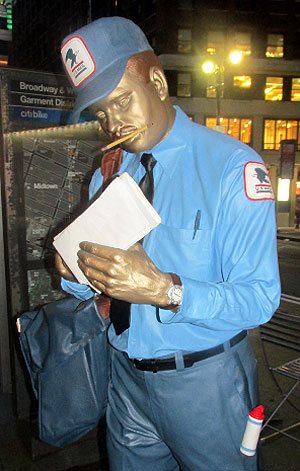
Photo by Jim Hill
… the hot dog vendor working at his cart …

Photo by Jim Hill
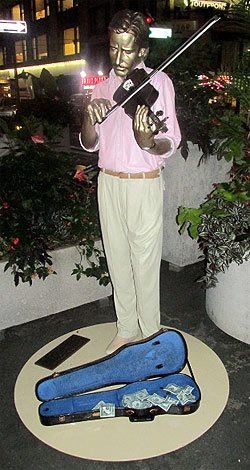
Photo by Jim Hill
… the street musician playing for tourists …
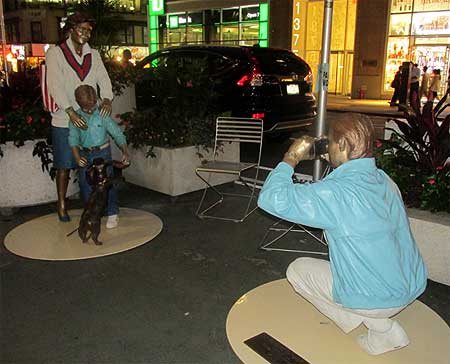
Photo by Jim Hill
Not to mention the tourists themselves.

Photo by Jim Hill
But right alongside the bronze businessmen …
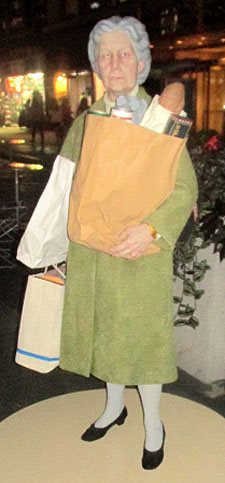
Photo by Jim Hill
… and the tired grandmother hauling her groceries home …
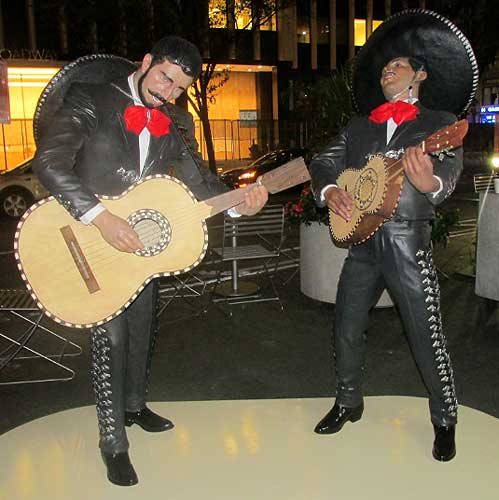
Photo by Jim Hill
… there were also statues representing people who were
from out-of-town …
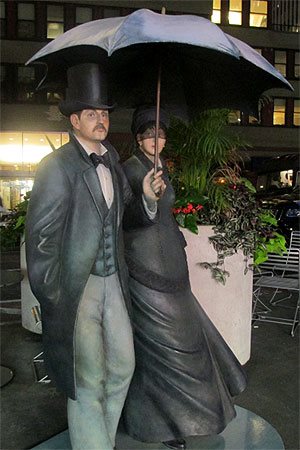
Photo by Jim Hill
… or — for that matter — out-of-time.
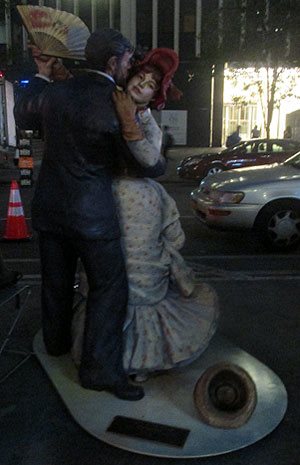
Photo by Jim Hill
These were the Seward Johnson pieces that genuinely beguiled. Famous impressionist paintings brought to life in three dimensions.
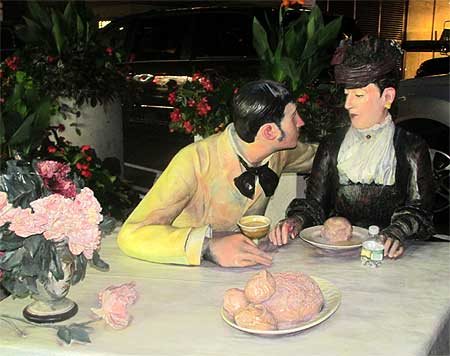
Note the out-of-period water bottle that some tourist left
behind. Photo by Jim Hill
Some of them so lifelike that you actually had to pause for
a moment (especially as day gave way to night in the city) and say to yourself
"Is that one of the bronzes? Or just someone pretending to be one of these
bronzes?"
Mind you, for those of you who aren't big fans of the
impressionists …
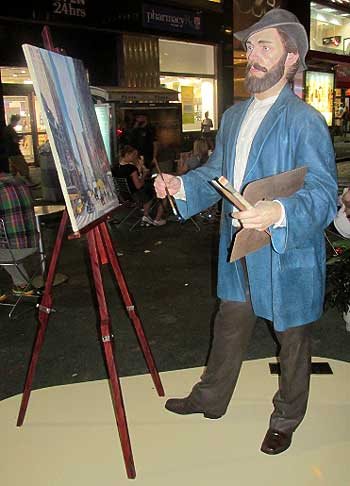
Photo by Jim Hill
… there's also an array of American icons. Among them
Marilyn Monroe …

Photo by Jim Hill
… and that farmer couple from Grant Wood's "American
Gothic."
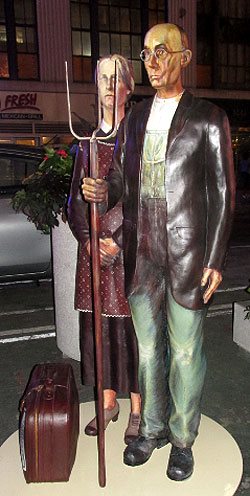
Photo by Jim Hill
But for those of you who know your NYC history, it's hard to
beat that piece which recreates Alfred Eisenstaedt's famous photograph of V-J Day in Times Square.

Photo by Jim Hill
By the way, a 25-foot-tall version of this particular Seward
Johnson piece ( which — FYI — is entitled "Embracing Peace") will actually
be placed in Times Square for a few days on or around August 14th to commemorate the 70th
anniversary of Victory Over Japan Day (V-J Day).
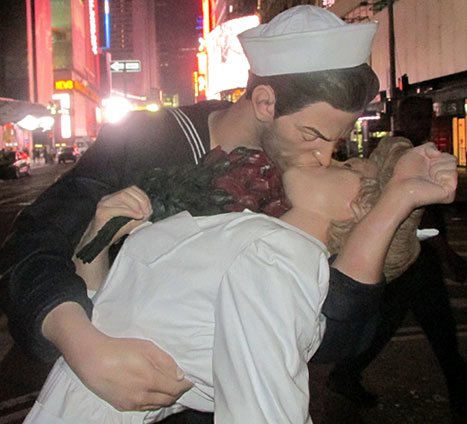
Photo by Jim Hill
By the way, if you'd like to check these Seward Johnson bronzes in
person (which — it should be noted — are part of the part of the Garment
District Alliance's new public art offering) — you'd best schedule a trip to
the City sometime over the next three months. For these pieces will only be on
display now through September 15th.
General
Wondering what you should “Boldly Go” see at the movies next year? The 2015 Licensing Expo offers you some clues

Greeting from the 2015 Licensing Expo, which is being held
at the Mandalay Bay
Convention Center in Las
Vegas.

Photo by Jim Hill
I have to admit that I enjoy covering the Licensing Expo.
Mostly becomes it allows bloggers & entertainment writers like myself to
get a peek over the horizon. Scope out some of the major motion pictures &
TV shows that today's vertically integrated entertainment conglomerates
(Remember when these companies used to be called movie studios?) will be
sending our way over the next two years or so.
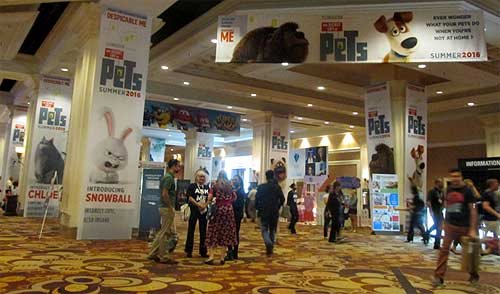
Photo by Jim Hill
Take — for example — all of "The Secret Life of
Pets" banners that greeted Expo attendees as they made their way to the
show floor today. I actually got to see some footage from this new Illumination
Entertainment production (which will hit theaters on July 8, 2016) the last time I was in Vegas. Which
was for CinemaCon back in April. And the five or so minutes of film that I viewed
suggested that "The Secret Life of Pets" will be a really funny
animated feature.
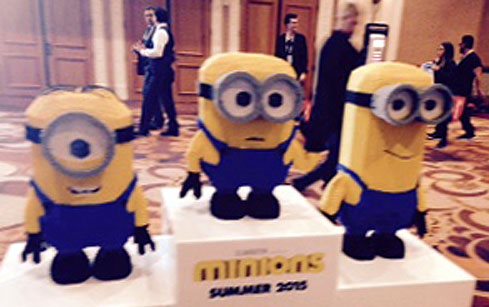
Photo by Jim Hill
Mind you, Universal Pictures wanted to make sure that Expo
attendees remembered that there was another Illumination Entertainment production
coming-to-a-theater-near-them before "The Secret Life of Pets" (And
that's "Minions," the "Despicable Me" prequel. Which
premieres at the Annecy International Animated Film Festival next week but
won't be screened stateside 'til July 10th of this year). Which is why they had
three minions who were made entirely out of LEGOS loitering out in the lobby.
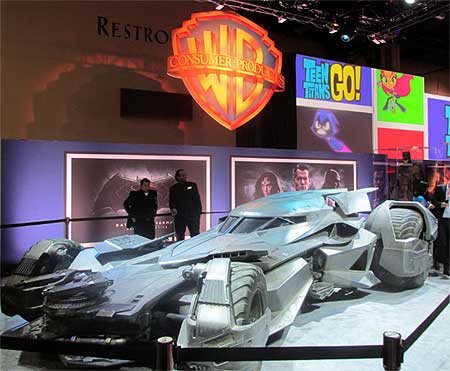
Photo by Jim Hill
And Warner Bros. — because they wanted "Batman v
Superman: Dawn of Justice" to start trending on Twitter today — brought
the Batmobile to Las Vegas.
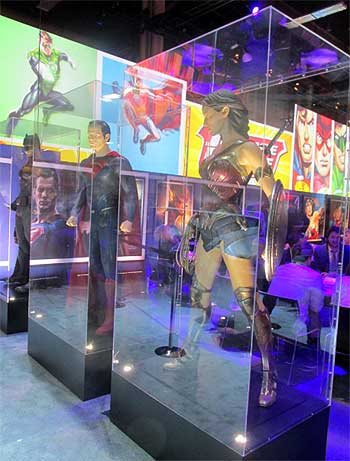
Photo by Jim Hill
Not to mention full-sized macquettes of Batman, Superman and
Wonder Woman. Just so conventioneers could then see what these DC superheroes
would actually look like in this eagerly anticipated, March 25, 2016 release.
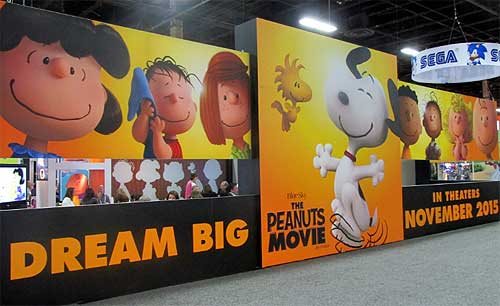
Photo by Jim Hill
That's the thing that can sometimes be a wee bit frustrating
about the Licensing Expo. It's all about delayed gratification. You'll come
around a corner and see this 100 foot-long ad for "The Peanuts Movie"
and think "Hey, that looks great. I want to see that Blue Sky Studios production
right now." It's only then that you notice the fine print and realize that
"The Peanuts Movie" doesn't actually open in theaters 'til November
6th of this year.
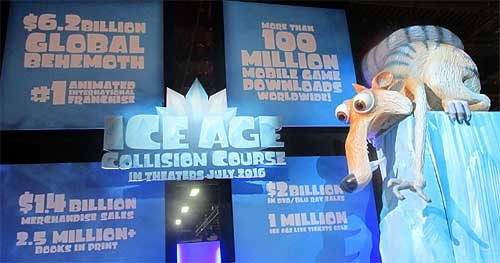
Photo by Jim Hill
And fan of Blue Sky's "Ice Age" film franchise are in for an even
longer wait. Given that the latest installment in that top grossing series
doesn't arrive in theaters 'til July
15, 2016.
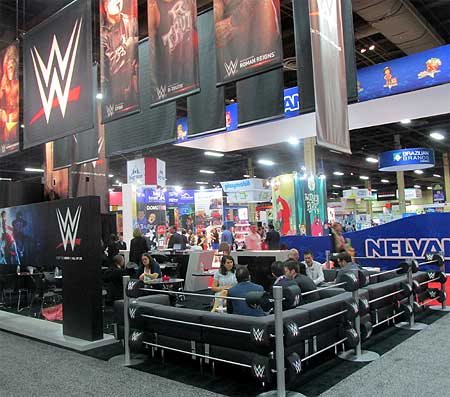
Photo by Jim Hill
Of course, if you're one of those people who needs immediate
gratification when it comes to your entertainment, there was stuff like that to
be found at this year's Licensing Expo. Take — for example — how the WWE
booth was actually shaped like a wrestling ring. Which — I'm guessing — meant
that if the executives of World Wrestling Entertainment, Inc. didn't like
the offer that you were making, they were then allowed to toss you out over the
top rope, Royal Rumble-style.

Photo by Jim Hill
I also have to admit that — as a longtime Star Trek fan —
it was cool to see the enormous Starship Enterprise that hung in place over the
CBS booth. Not to mention getting a glimpse of the official Star Trek 50th
Anniversary logo.
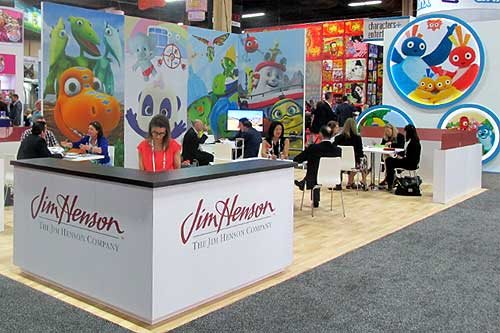
Photo by Jim Hill
I was also pleased to see lots of activity in The Jim Henson
Company booth. Which suggests that JHC has actually finally carved out a
post-Muppets identity for itself.
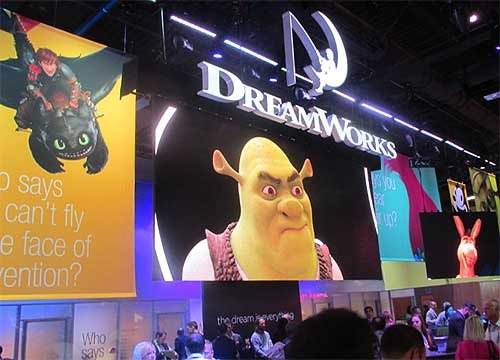
Photo by Jim Hill
Likewise for all of us who were getting a little concerned
about DreamWorks Animation (what with all the layoffs & write-downs &
projects that were put into turnaround or outright cancelled last year), it was
nice to see that booth bustling.
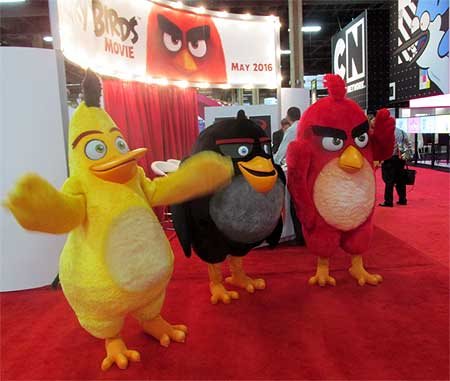
Photo by Jim Hill
Every so often, you'd come across some people who were
promoting a movie that you weren't entirely sure that you actually wanted to
see (EX: "Angry Birds," which Sony Pictures Entertainment / Columbia
Pictures will be releasing to theaters on May 20, 2016). But then you remembered that Clay Kaytis —
who's this hugely talented former Walt Disney Animation Studios animator — is
riding herd on "Angry Birds" with Fergal Reilly. And you'd think
"Well, if Clay's working on 'Angry Birds,' I'm sure this animated feature
will turn out fine."
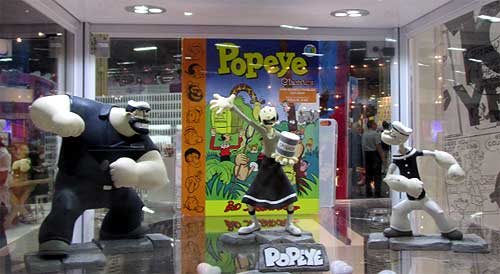
Photo by Jim Hill
Mind you, there were reminders at this year's Licensing Expo
of great animated features that we're never going to get to see now. I still
can't believe — especially after that brilliant proof-of-concept footage
popped up online last year — that Sony execs decided not to go forward
with production of Genndy Tartakovsky's
"Popeye" movie. But that's the
cruel thing about the entertainment business, folks. It will sometime break
your heart.
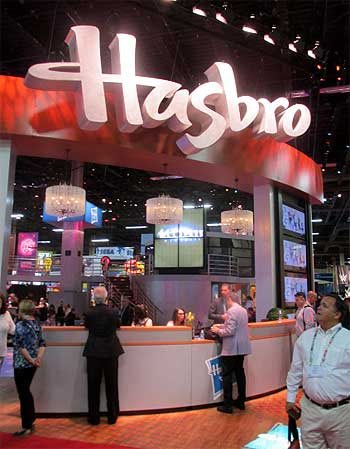
Photo by Jim Hill
And make no mistake about this. The Licensing Expo is all
about business. That point was clearly driven home at this year's show when —
as you walked through the doors of the Mandalay
Bay Convention Center
— the first thing that you saw was the Hasbros Booth. Which was this gleaming,
sleek two story-tall affair full of people who were negotiating deals &
signing contracts for all of the would-be summer blockbusters that have already
announced release dates for 2019 & beyond.
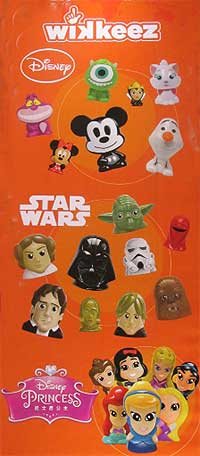
Photo by Jim Hill
"But what about The Walt Disney Company?," you
ask. "Weren't they represented on the show floor at this year's Licensing
Expo?" Not really, not. I mean, sure. There were a few companies there hyping
Disney-related products. Take — for example — the Disney Wikkeez people.
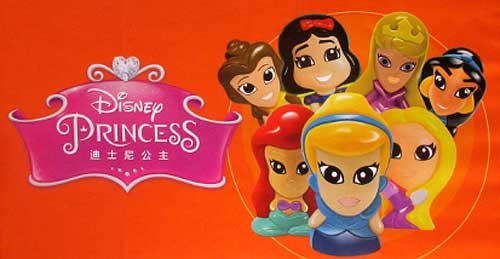
Photo by Jim Hill
I'm assuming that some Disney Consumer Products exec is
hoping that Wikkeez will eventually become the new Tsum Tsum. But to be blunt,
these little hard plastic figures don't seem to have the same huggable charm
that those stackable plush do. But I've been wrong before. So let's see what
happens with Disney Wikkeez once they start showing up on the shelves of the
Company's North American retail partners.

Photo by Jim Hill
And speaking of Disney's retail partners … They were
meeting with Mouse House executives behind closed doors one floor down from the
official show floor for this year's Licensing Expo.
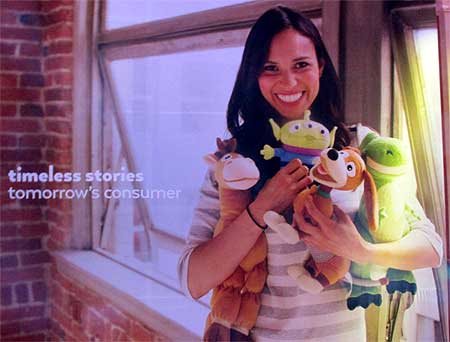
Photo by Jim Hill
And the theme for this year's invitation-only Disney shindig? "Timeless
Stories" involving the Disney, Pixar, Marvel & Lucasfilm brands that
would then appeal to "tomorrow's consumer."

Photo by Jim Hill
And just to sort of hammer home the idea that Disney is no
longer the Company which cornered the market when it comes to little girls
(i.e., its Disney Princess and Disney Fairies franchises), check out this
wall-sized Star Wars-related image that DCP put up just outside of one of its
many private meeting rooms. "See?," this carefully crafted photo
screams. "It isn't just little boys who want to wield the Force. Little
girls also want to grow up and be Lords of the Sith."

Photo by Jim Hill
One final, kind-of-ironic note: According to this banner,
Paramount Pictures will be releasing a movie called "Amusement Park"
to theaters sometime in 2017.
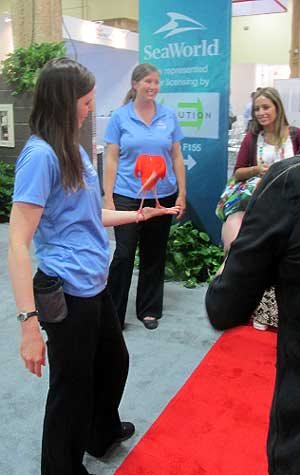
Photo by Jim Hill
Well, given all the "Blackfish" -related issues
that have been dogged SeaWorld Parks & Entertainment over the past two years, I'm
just hoping that they'll still be in the amusement park business come 2017.
Your thoughts?
General
It takes more than three circles to craft a Classic version of Mickey Mouse

You know what Mickey Mouse looks like, right? Little guy,
big ears?
Truth be told, Disney's corporate symbol has a lot of
different looks. If Mickey's interacting with Guests at Disneyland
Park (especially this summer, when
the Happiest Place on Earth
is celebrating its 60th anniversary), he looks & dresses like this.
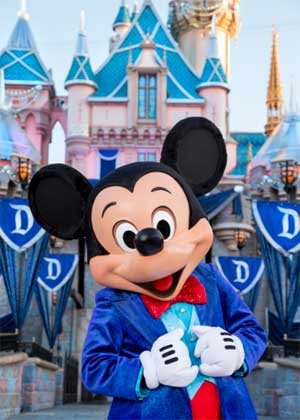
Copyright Disney Enterprises,
Inc.
All rights reserved
Or when he's appearing in one of those Emmy Award-winning shorts that Disney
Television Animation has produced (EX: "Bronco Busted," which debuts
on the Disney Channel tonight at 8 p.m. ET / PT), Mickey is drawn in a such a
way that he looks hip, cool, edgy & retro all at the same time.
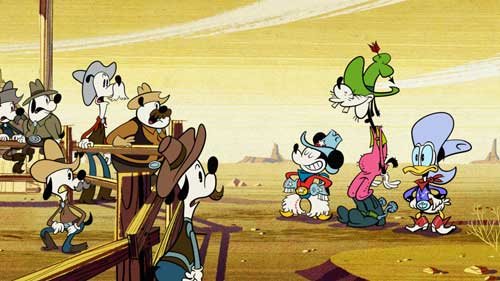
Copyright Disney Enterprises, Inc. All rights
reserved
Looking ahead to 2017 now, when Disney Junior rolls out "Mickey and the
Roadster Racers," this brand-new animated series will feature a sportier version
of Disney's corporate symbol. One that Mouse House managers hope will persuade
preschool boys to more fully embrace this now 86 year-old character.
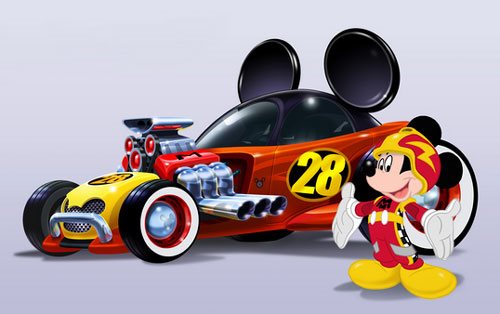
Copyright Disney Enterprises,
Inc. All rights reserved
That's what most people don't realize about the Mouse. The
Walt Disney Company deliberately tailors Mickey's look, even his style of
movement, depending on what sort of project / production he's appearing in.
Take — for example — Disney
California Adventure
Park's "World of Color:
Celebrate!" Because Disney's main mouse would be co-hosting this new
nighttime lagoon show with ace emcee Neil Patrick Harris, Eric Goldberg really had
to step up Mickey's game. Which is why this master Disney animator created
several minutes of all-new Mouse animation which then showed that Mickey was
just as skilled a showman as Neil was.
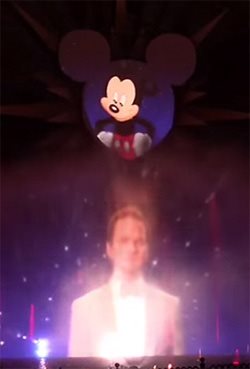
Copyright Disney Enterprises,
Inc.
All rights reserved
Better yet, let's take a look at what the folks at Avalanche Studios just went
through as they attempted to create a Classic version of Mickey & Minnie.
One that would then allow this popular pair to become part of Disney Infinity
3.0.
"I won't lie to you. We were under a lot of pressure to
get the look of this particular version of Mickey — he's called Red Pants
Mickey around here — just right," said Jeff Bunker, the VP of Art
Development at Avalanche Studios, during a recent phone interview. "When
we brought Sorcerer Mickey into Disney Infinity 1.0 back in January of 2014,
that one was relatively easy because … Well, everyone knows what Mickey Mouse
looked like when he appeared in 'Fantasia.' "
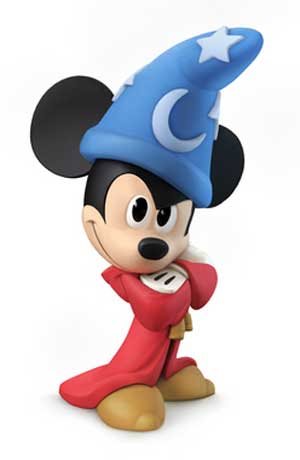
Copyright Disney Enterprises,
Inc. All rights reserved
"But this time around, we were being asked to design
THE Mickey & Minnie," Bunker continued. "And given that these Classic
Disney characters have been around in various different forms for the better
part of the last century … Well, which look was the right look?"
Which is why Jeff and his team at Avalanche Studios began watching hours &
hours of Mickey Mouse shorts. As they tried to get a handle on which look would
work best for these characters in Disney Infinity 3.0.
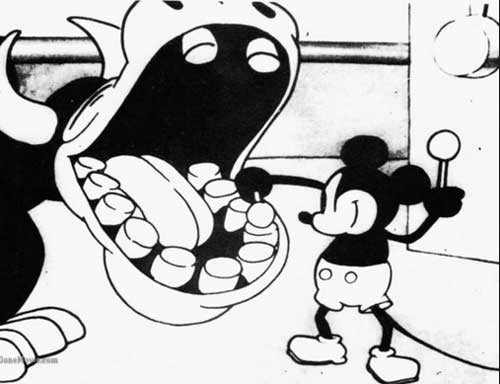
Copyright Disney
Enterprises, Inc. All rights reserved
"And we went all the way back to the very start of Mickey's career. We began
with 'Steamboat Willie' and then watched all of those black & white Mickey shorts
that Walt made back in the late 1920s & early 1930s. From there, we
transitioned to his Technicolor shorts. Which is when Mickey went from being
this pie-eyed, really feisty character to more of a well-behaved leading
man," Bunker recalled. "We then finished out our Mouse marathon by
watching all of those new Mickey shorts that Paul Rudish & his team have
been creating for Disney Television Animation. Those cartoons really recapture
a lot of the spirit and wild slapstick fun that Mickey's early, black &
white shorts had."
But given that the specific assignment that Avalanche Studios had been handed
was to create the most appealing looking, likeable version of Mickey Mouse
possible … In the end, Jeff and his team wound up borrowing bits & pieces
from a lot of different versions of the world's most famous mouse. So that
Classic Mickey would then look & move in a way that best fit the sort of
gameplay which people would soon be able to experience with Disney Infinity
3.0.
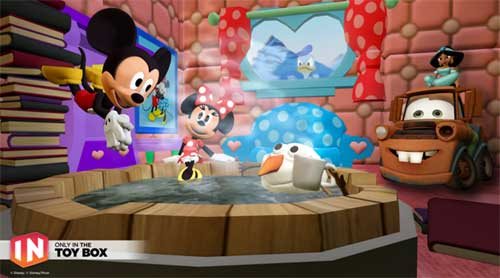
Copyright Disney Enterprises,
Inc. All rights reserved
"That — in a lot of ways — was actually the toughest
part of the Classic Mickey design project. You have to remember that one of the
key creative conceits of Disney Infinity
is that all the characters which appear in this game are toys," Bunker
stated. "Okay. So they're beautifully detailed, highly stylized toy
versions of beloved Disney, Pixar, Marvel & Lucasfilm characters. But
they're still supposed to be toys. So our Classic versions of Mickey &
Minnie have the same sort of thickness & sturdiness to them that toys have.
So that they'll then be able to fit right in with all of the rest of the
characters that Avalanche Studios had previously designed for Disney Infinity."
And then there was the matter of coming up with just the
right pose for Classic Mickey & Minnie. Which — to hear Jeff tell the
story — involved input from a lot of Disney upper management.
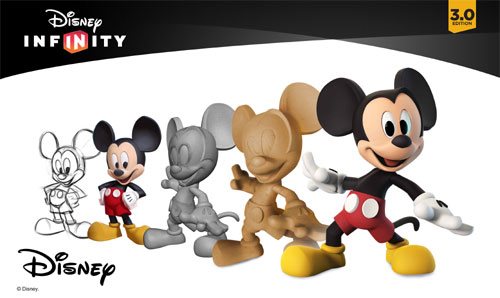
Copyright Disney Enterprises,
Inc. All rights reserved
"Everyone within the Company seemed to have an opinion
about how Mickey & Minnie should be posed. More to the point, if you Google
Mickey, you then discover that there are literally thousands of poses out there
for these two. Though — truth be told — a lot of those kind of play off the
way Mickey poses when he's being Disney's corporate symbol," Bunker said.
"But what I was most concerned about was that Mickey's pose had to work
with Minnie's pose. Because we were bringing the Classic versions of these
characters up into Disney Infinity 3.0 at the exact same time. And we wanted to
make sure — especially for those fans who like to put their Disney Infinity
figures on display — that Mickey's pose would then complement Minnie.
Which is why Jeff & the crew at Avalanche Studios
decided — when it came to Classic Mickey & Minnie's pose — that they
should go all the way back to the beginning. Which is why these two Disney icons
are sculpted in such a way that it almost seems as though you're witnessing the
very first time Mickey set eyes on Minnie.

Copyright Disney Enterprises,
Inc. All rights reserved
"And what was really great about that was — as soon as
we began showing people within the Company this pose — everyone at Disney
quickly got on board with the idea. I mean, the Classic Mickey that we sculpted
for Disney Infinity 3.0 is clearly a very playful, spunky character. But at the
same time, he's obviously got eyes for Minnie," Bunker concluded. "So
in the end, we were able to come up with Classic versions of these characters
that will work well within the creative confines of Disney Infinity 3.0 but at
the same time please those Disney fans who just collect these figures because
they like the way the Disney Infinity characters look."
So now that this particular design project is over, does
Jeff regret that Mouse House upper management was so hands-on when it came to
making sure that the Classic versions of Mickey & Minnie were specifically
tailored to fit the look & style of gameplay found in Disney Infinity 3.0?
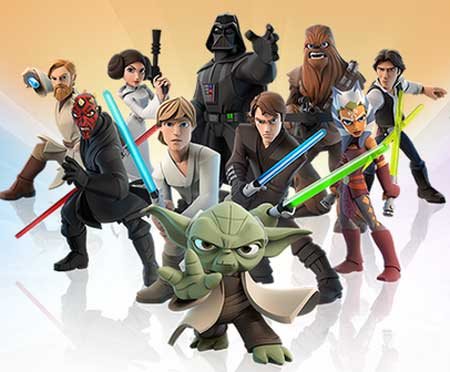
Copyright Lucasfilm / Disney
Enterprises, Inc. All rights reserved
"To be blunt, we go through this every time we add a new character to the
game. The folks at Lucasfilm were just as hands-on when we were designing the
versions of Darth Vader and Yoda that will also soon be appearing in Disney
Infinity 3.0," Bunker laughed. "So in the end, if the character's
creators AND the fans are happy, then I'm happy."
This article was originally posted on the Huffington Post's Entertainment page on Tuesday, June 9, 2015
-

 History11 months ago
History11 months ago31 Long-Gone Rides, Shows & Attractions at Disney-MGM (Hollywood Studios)
-

 News & Press Releases8 months ago
News & Press Releases8 months agoDisney Will Bring D23: The Ultimate Disney Fan Event to Anaheim, California in August 2024
-

 History4 months ago
History4 months agoFrom Birthday Wishes to Toontown Dreams: How Toontown Came to Be
-

 Theme Parks & Themed Entertainment12 months ago
Theme Parks & Themed Entertainment12 months agoFrom Aladdin to Indy – How Did We Get an Indiana Jones Stage Show at Disneyland?
-

 Theme Parks & Themed Entertainment12 months ago
Theme Parks & Themed Entertainment12 months agoHow Did We Get “Aladdin’s Oasis” at Disneyland?
-

 Theme Parks & Themed Entertainment11 months ago
Theme Parks & Themed Entertainment11 months agoWhen WDW Had a Racetrack – The Creation of the Walt Disney World Speedway
-

 Film & Movies10 months ago
Film & Movies10 months ago“Indiana Jones and the Search for Indiana Jones”
-

 History3 months ago
History3 months agoUnpacking the History of the Pixar Place Hotel









